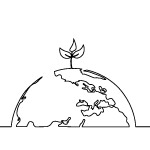Protecting the future with the UN's 17 SDGs


What are the 17 UN Sustainable Development Goals?
The United Nations, in 2015, adopted the 17 Sustainable Development Goals with the aim of charting a path of peace and prosperity for the world to achieve by 2030.
It is an unprecedented effort to establish a methodology and criteria aimed at positively impacting the planet, Society and international relations for both developed and developing countries.
The criteria are applicable by individual countries and companies and are a source of inspiration for world leaders. They form the basis of our investment analysis work.
How we take them into account
Because the analysis of the SDGs is particularly complex, we have extracted a list of simplified, easier-to-read impact areas that address all aspects marked by the UN on the 2030 sustainability pathway.
We then checked for feedback in the management processes of Society and developed objective rankings of "ESG intensity."
Here are the selected themes and how they relate to the UN''s 17 SDGs.
Environmental aspects

In the fight against climate change, we include Goals 7 (strengthen low-cost access to renewable energy) and 13 (take action to prevent climate change and mitigate its effects).

The theme of natural resource conservation calls for a transformation of production processes by promoting material recycling andeco-sustainability, as well as new consumption habits (SDG 12), also rests on 'sustainable agriculture (SDG 2) and the preservation of ecosystems on land (SDG 15) and in water (SDG 14).

It is mandatory to protect biodiversity both in urban areas (SDG 11 - Sustainable Cities) and in natural environments, through sustainable agriculture integrated into the environment (SDG 2) and preservation of ecosystems on land (SDG 15) and in water (SDG 14).

Taking 360-degree environmental action means dealing with all other causes of degradation resulting from human action: wars (SDG 16) resulting from a lack of international cooperation (SDG 17), migration flows associated with poverty (SDG 10), andpollution issues due to obsolete industrial practices (SDG 9).
The aspects of the Society

Securing peoples' basic needs means defeating poverty (SDG 1) and hunger (SDG 2), providing access to water and sanitation (SDG 6), education (SDG 4) and basic infrastructure (SDG 9), enabling people to have jobs (SDG 8).

Enabling populations to stay healthy comes through a quality health system (SDG 3), creating inclusive and safe cities (SDG 11) and promoting sustainable communities (SDG 16) by reducing social inequalities (SDG 10).

Making the economy sustainable means renewing industry and infrastructure (SDG 9), providing suitable jobs for all and enhancing growth (SDG 8) strengthening the circular economy (SDG 12) in a context of improved cities (SDG 11).

Ensuring sustainability at work requires strengthening the themes of equality and inclusion (SDG 5), reducing inequality (SDG 10), facilitating education (SDG 4) and access to work (SDG 8) and security (SDG 3).

Promoting inclusion and equality of opportunity at Society means strengthening gender equality issues (SDG 5), reducing inequality (SDG 10), facilitating education (SDG 4) and setting strong institutional principals (SDG 16).

Social equity includes all elements that federate or undo peoples: international relations (SDG 17), the fight for justice values such as anti-corruption and tax evasion (SDG 16), combating poverty (SDG 1) and wealth sharing (SDG 10), child exploitation (SDG 8) and women exploitation (SDG 5).
The aspects of good governance

Bringing the culture of peace to the world means reducing tensions both between states and between inhabitants, converging toward internationally coordinated goals of peaceful coexistence (SDG 17) (SDG 16) through a better distribution of wealth in the world (SDG 10) and through a planet-friendly economy (SDG 11) that protects economic security (SDG 8) and people's health (SDG 3).

International cooperation to achieve the goals of the 2030 plan concerns everyone, rich and developing countries, Society and people (SDG 17), through an evolution of our habits (SDG 16), using technology (SDG 9) and knowledge (SDG 4) to create a positive world.

Good governance is a global issue that involves everyone-individuals, businesses, and communities: the pursuit of good practices passes through an effective system of monitoring the conduct of business and politics. Thus, compliance with treaties and codes of ethics that permeate all SDGs are relevant.


